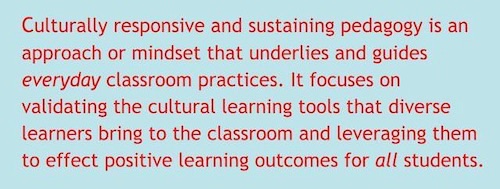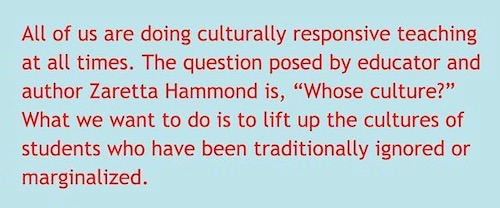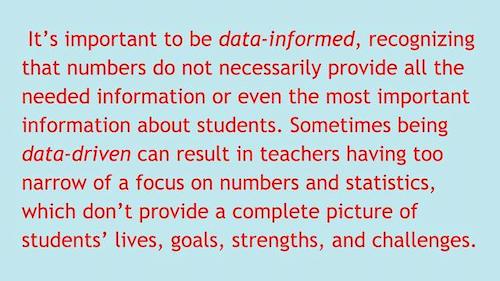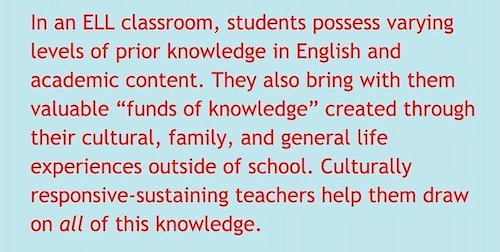Teaching So We Are Both Culturally Responsive and Sustaining
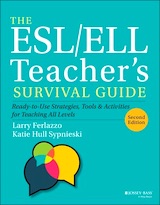
By Larry Ferlazzo and Katie Hull Sypnieski

Larry
There was a relatives that lived on the Cavally River in Liberia: a hunter, his spouse, and their 3 sons the mother was anticipating another boy or girl before long. Just one morning the hunter went into the forest. Night arrived the hunter didn’t arrive property.
A 7 days handed. A month. The boys began hunting on their individual they did not talk about their absent father. Then, the mother gave beginning to a daughter. Time passed. The little one lady figured out to crawl, to stand up, to wander, and then to communicate.
Her to start with phrases ended up “Where is my father?”
“Yes,” said the very first brother. “Where is he?”
“We ought to obtain out what transpired to him,” stated the next brother.
“Let’s go!” mentioned the 3rd brother.

Katie
The first son experienced a sixth sense that allowed him to come across their father’s body in the forest a wild animal had killed him. Only his bones were left. The second son knew a magic spell to place flesh again on their father’s bones. The third son experienced the electric power to breathe lifestyle back again into their father’s physique. Their father rose up, thanked his sons, and they all went house together. The complete village celebrated the hunter’s return.
“Whom shall we honor? Who rescued this gentleman?” the chief requested.
The sons began arguing. “I identified him!” “I set flesh on his bones!” “I breathed daily life into his system!”
The villagers also started arguing. The main could not determine which son to honor.
Then the mother stepped forward. “Our daughter warrants the honor,” the mother proclaimed, “because she found that her father was lacking and questioned: Where is my father?”
Everyone agreed with the mother’s verdict, and they honored the smart minimal woman.
Noticing What Is Lacking
As this folktale teaches, each particular person has a important contribution to make, and occasionally the most important contribution is to detect what is lacking. What is normally lacking from instruction in our faculties is acknowledgement and celebration of our students’ identities and cultures.
When the greater part of students in US community colleges are college students of shade from linguistically and culturally varied backgrounds, the large greater part of educators (about 80 %) in K-12 community universities are white. Many pupils have been harmed by pedagogy that has not acknowledged systemic racism, and educators perform an vital position in either addressing or not addressing these harms. In gentle of greater community attention to law enforcement violence versus people today of coloration and a counter-response by conservatives opposing anti-racism teaching in educational facilities, educators should really be intentional in addressing their very own biases and practicing culturally responsive and sustaining instructing.
Although we are singling out this element of instructing multilinguals, we in no way want to imply that culturally sustaining training is optional or that it occurs only on sure days or in sure routines. As we will explain, culturally responsive and sustaining pedagogy is an method or mindset that underlies and guides everyday classroom practices. It focuses on validating the cultural discovering applications that varied learners carry to the classroom and leveraging them to impact optimistic understanding results for all pupils.
What is Culturally Responsive and Sustaining Teaching?
Culturally responsive educating (CRT) and culturally sustaining pedagogy (CSP) are two of the most-popular philosophies guiding how teachers of all races can be far better academics to pupils of color. These ways are crafted on the foundational work of educator and researcher Dr. Gloria Ladson-Billings. She introduced the phrase culturally related pedagogy to explain a educating technique centered on engaging learners whose encounters and cultures were often considered as a result of a “deficit” lens and typically excluded in mainstream academic configurations.
Geneva Gay expanded on the get the job done of Ladson-Billings and recognized the term culturally responsive educating to explain pedagogy that works by using “the cultural expertise, prior experiences, frames of reference, and performance models of ethnically varied pupils to make mastering encounters additional suitable to and successful for them.”
Culturally sustaining pedagogy is a extra the latest point of view that builds on the tenets of culturally responsive and suitable educating. This method was first proposed by professor Django Paris, who defines it as a pedagogy that “seeks to perpetuate and foster – to maintain – linguistic, literate, and cultural pluralism as aspect of schooling for constructive social transformation and revitalization.”
In other text, this tactic prioritizes creating positive that our educational methods not only reply to the range of languages and cultures in our classroom, but also that they aim to maintain these elements at the heart of instructing and studying. As Zaretta Hammond, educator and creator of the reserve Culturally Responsive Training and the Mind, details out: all of us are undertaking culturally responsive instructing at all periods. The problem posed by Hammond is, “Whose society?” What we want to do is to carry up the cultures of students who have been ordinarily ignored or marginalized.
Viewing English language learners through an asset, not deficit, dependent lens guides all that we do in the classroom. Instruction that is culturally responsive and sustaining explicitly difficulties the deficit perspective. We feel that recognizing, validating, and using the many linguistic and cultural tools that ELLs possess eventually supplies the most effective understanding activities for our students and for us.
The Organizing Cycle
In our new ebook we examine how the Organizing Cycle (based on productive tactics made use of by group organizers) can be applied as a helpful framework for earning studying extra available to ELLs and to all learners.
These very same analysis-based rules of making student associations, accessing prior information (specifically via college student stories), establishing student leadership likely, learning by executing, and reflection can also perform as a body for discussing culturally responsive and sustaining pedagogy in the ELL classroom.
Under (and in Component 2 of this posting) we offer you tips and tactics for each individual principle of the Organizing Cycle. While these factors really don’t protect each aspect of culturally responsive instructing, they do stand for foundational most effective practices we use in our lecture rooms.
We hope our discussion right here can spur continued study and deepen finding out in your own exercise. And yet again, we want to emphasize culturally responsive and sustaining instructing is not a “program” or record of strategies. It is a frame of mind that influences all the things we do in the classroom.
Creating Powerful Associations
Several educators look at good associations with college students as a classroom management resource. However, a culturally responsive, sustaining educator sights these relationships as a significant foundation of understanding.
Zaretta Hammond describes the relationship involving our brain’s skill to master and positive associations: “The oxytocin good associations trigger allows the amygdala keep calm so the prefrontal cortex can emphasis on increased buy wondering and finding out.” To put it basically, favourable relationships in the classroom aid students to feel safe and sound. When they experience risk-free, they can much better master. In an ELL classroom that is culturally responsive and sustaining, setting up favourable associations can require:
►Taking the time to pay attention and to understand about our college students as a result of the connection creating and sustaining functions. We share many methods for accomplishing this in Chapter Two of our e-book.
►Gathering details about college students from the school (English Proficiency Amount, property language study, well being information, transcripts, assessments, and so on). This info can deliver context for conversations with students and their families. On the other hand, it’s crucial to be info-knowledgeable, recognizing that figures do not necessarily offer all the essential details or even the most crucial data that instructors want to know about their learners. At times being information-driven can consequence in instructors obtaining far too slim of a concentration on figures and data, which never offer a entire photograph of students’ life, aims, strengths, and issues.
►Learning about students’ home nations – present conflicts/problems, particular details on the town or area they occur from, language(s) they speak, and so on. – from college students, their households, and your own analysis.
►Becoming familiar with the neighborhoods learners now live in can make it less difficult for lecturers to join students’ every day experiences to the classroom and establish deeper associations with students and their people.
►Gathering data on students’ tutorial strengths and troubles as a result of discussions with college students and their households (We like to request mom and dad: “What is anything that has assisted your little one learn finest?” “When has your youngster been most productive in school and what contributed to that achievements?”), typical test-ins, and near observations of college students and their get the job done.
►Giving surveys to students inquiring about their pursuits, goals, and comments on the class can strengthen relationships if the instructor acts on this details. Asking college students to fill out a Google form and then not acting on any of the comments from learners can be perceived as “performative” and can guide pupils to feel that the trainer does not truly treatment about them or what they believe.
►Using the set up, maintain, restore framework, which has been discovered by researchers to be a person of the most effective procedures for good marriage developing. This partnership framework entails 1st developing favourable interactions at the beginning of the yr employing strategies like the types we describe in Chapter Two.
►Positive, trusting interactions need to then be maintained all over the yr by continuing to carry out those techniques and being aware of favourable and negative interactions with college students (investigation exhibits academics must intention for a five-to-just one ratio).
►When adverse interactions do come about, then associations ought to be repaired or restored. Some of the techniques academics can enable restore favourable interactions include things like admitting their own faults, using accountability for their steps, apologizing when required, not blaming students when points go incorrect, letting learners to have a “fresh start” every single day, asking learners what they need to have to go ahead, and showing empathy. It can also be essential to remember that when we are apologizing to pupils, we want the target to be on the college student – how they are experience, how the oversight affected them, or what they require to shift forward.
►We just can’t say it more than enough times: taking the time to learn how to pronounce every single of your student’s names is important to partnership constructing, and if you get it mistaken, hold hoping till you get it correct!
We understand that several of these partnership-creating things to do can be hard when the trainer doesn’t share the exact same property language as the scholar. We stimulate you to see the Tech Resource in Chapter Two “Online Resources: Translating” for translation methods.
Accessing Prior Expertise (Primarily By means of Tales)
Research on the mind confirms it is less complicated to study one thing new when we can attach it to a little something we previously know. For ELLs in certain, activating prior know-how, also known as activating schema, performs a major position in selling their academic literacy.
In an ELL classroom, students possess varying levels of prior know-how in English and educational material. They also bring with them worthwhile “funds of knowledge” created as a result of their cultural, relatives, and typical life ordeals outside the house of faculty.
Culturally responsive-sustaining teachers of ELLs honor their students’ activities and understandings. They enable learners draw on their prior expertise, which includes those outside the house resources of understanding, in purchase to make connections to new learning.
As soon as teachers elicit from students what they previously know and have seasoned about a subject matter or notion, they can then come to a decision how substantially supplemental background expertise is desired for pupils to realize new material.
In Chapter 7 of our reserve, we involve unique examples of eliciting and developing background expertise with ELLs. Right here are a several far more techniques we guidance learners to share and build on their expertise and activities in culturally sustaining approaches:
►Listening, listening, and more listening! Teachers can not assist college students entry and expand prior knowledge if the instructor is accomplishing all the talking. In some cases lecturers leave out the “accessing prior knowledge” stage and move straight to “building qualifications knowledge” by explaining just about every word, strategy, or matter to their learners. Not only can this be bewildering and mind-boggling for students, but it devalues students’ prior understanding and experiences. In addition, teachers should don’t forget that college students could have an comprehending of a strategy that is “different” from the teacher’s prior knowledge as opposed to “incorrect.” For instance, asking college students from distinct cultural backgrounds to write what they know about health care and medicine may possibly elicit really distinctive responses from just one written by the instructor.
►Using what we phone “brain sparks” to get students wondering, talking, crafting, and sharing about a topic or concept we will be teaching. When commencing a new unit, text, or notion, we frequently display learners a similar movie (quite possibly at a diminished speed and definitely with English subtitles), an impression, a slideshow, or other visual and check with them queries like “What do you see?” “What do you come across exciting?” or “What does this remind you of?” Simply just asking students to create or discuss about it with a associate can gauge prior know-how, build background, and create desire. Newcomers can answer in their dwelling language or even by way of drawing photographs of what they previously know about the matter.
►Validating and encouraging students’ use of their house language when activating and making prior expertise (which include giving texts in their house language on the subject matter of review). This viewpoint is also identified as translanguaging where learners are inspired to leverage the linguistics equipment of all the languages they know in purchase to build their dwelling and next (or perhaps their 3rd, fourth, or even fifth) language, content material, tutorial, and social abilities.
►Encouraging pupils to often share their cultural and linguistic information with every single other. This sharing can transpire extra formally by projects or student shows wherever college students educate each individual other about their house cultures and their dwelling languages. Even straightforward, casual tactics like asking students to come to the board and translate a essential vocabulary term into their various house languages (followed by the trainer trying to say the term in each language) can instantly be affirming and inject some humor (at the teacher’s price!) into the lesson.
Providing space and time for pupils to consider and share the diverse methods they clear up challenges, how they could method an exercise, what will work/does not work most effective for them when studying, the similarities and variances of their house languages, and lots of other types of prior expertise and encounter can assistance teachers generate what Zaretta Hammond phone calls “cognitive hooks” amongst students’ precious cash of information and tutorial written content.
In Portion 2 (coming upcoming 7 days)
Larry and Katie examine these subject areas:
► Determining and Mentoring Students’ Management Potential
► Getting Students Study by Performing
► Issues to Promote Instructor Reflection
► The place to Come across Extra Sources on Culturally Responsive and Sustaining Educating
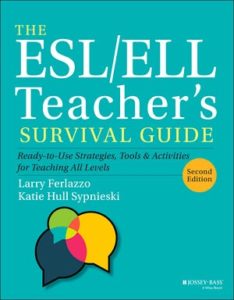
Katie Hull Sypnieski teaches English Language Learners and English-proficient college students at Arthur A. Benjamin Well being Professions Large University in Sacramento, California. She is a Trainer Consultant with the Area 3 Composing Undertaking at the College of California, Davis and is a co-creator of The ELL Teacher’s Toolbox and Navigating the Common Main with English Language Learners.
Larry and Katie are co-authors of the 1st and 2nd editions of The ESL/ELL Teacher’s Survival Information: Prepared-to-Use Tactics, Applications & Activities for Teaching All Degrees (Wiley/Jossey-Bass, 2022).

